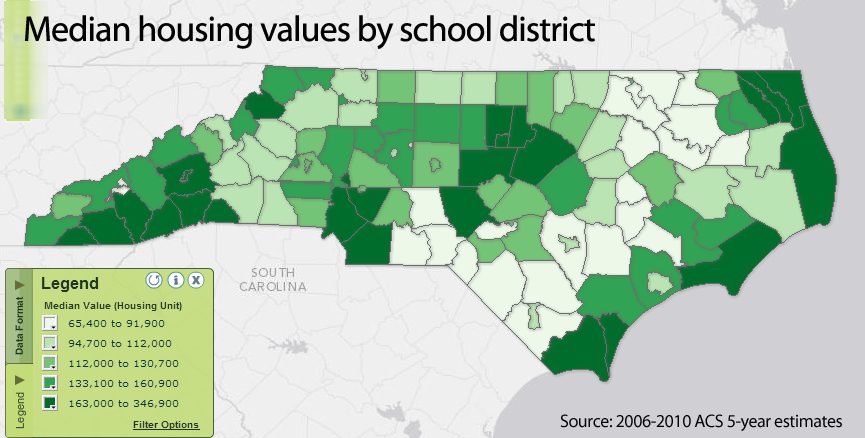N.C.’s TIMS project helps effort to update public school boundaries

Where your child (or grandchild or niece) goes to school is important to you personally. How the demographics of your child’s district compare to that of other districts across the country is important to researchers, policy makers and even disaster relief planners. A program used in North Carolina should streamline the work of updating this information in the state.
Learn More
Click here to go to the national, interactive version of the map displayed above.
Download a larger image of the map above here.
Data in the interactive tool also allow comparisons of school area populations by household types, veteran status, employment, commuting, occupation, housing characteristics, and race and ethnicity, among other factors.
In fall 2013, the National Center for Education Statistics (NCES) began a new data collection effort seeking the most current school attendance boundary information across all 50 states and the District of Columbia. With this information, NCES will be able to provide an openly accessible mapping system for all public school attendance zones in the nation. According to its website (nces.ed.gov/surveys/sdds/sabs), the project’s result will be a national database that can be used by school personnel, researchers and policy makers to examine relationships among schools within the same district or across the nation.
One example of the mapping that the project allows is shown above. Individual school boundaries (high school lines) can be compared locally, regionally, or across the country. The interactive map viewer is available now, with data from the 2010 Census as well as the 2006-2011 estimates. The planned update will review and revise the school boundaries and make more current Census data available for analysis. The map below shows an example of what is available for comparing district-level data.

Click on the map above to go to the Map Viewer tool from the National Center for Education Statistics.*
As school boundary information is acquired, it will be possible to aggregate other NCES and Census databases to the attendance zones for individual schools across the nation. This combined information can then be used at local, state and federal levels to help inform various policy decisions, funding processes and disaster relief programs.
NCES has contacted school superintendents across North Carolina over the past few months, and dozens of school districts have already agreed to take part in this voluntary, national survey of school attendance boundaries. NCES provides several methods for submitting boundary information, which can be in the form of paper maps or electronic shapefiles from school districts. If the information does not exist in either of those formats, NCES also gives the option of using online tool, available through the submission website, to draw the boundaries.
The good news for N.C. school districts is that their school attendance boundary information is readily available within the Transportation Information Management System (TIMS). TIMS primarily focuses on preserving and improving efficiency in school bus routing at the district level. Each school district is responsible for maintaining current and accurate school transportation information by operating this computer-assisted school bus routing and scheduling software.
In addition to housing bus stop locations, stop times and student ride times, TIMS houses the attendance zone information for individual schools. To help combat the current or projected overcrowding of schools in fast-growing areas, N.C. school districts frequently use TIMS data to study how any potential shifting of boundary lines would affect the number of students enrolled at each school.
TIMS’ existence has made participating in the NCES School Attendance Boundary Survey much easier, since school districts across North Carolina already have attendance boundary information readily available in an electronic format. With the assistance of TIMS Project Leaders from the UNC Charlotte Urban Institute (/programs/tims) and the Institute for Transportation Research and Education (ITRE) at N.C. State (http://www.itre.ncsu.edu/pupil/tims.html), several school districts across North Carolina have already submitted their current school attendance boundaries to the National Center for Education Statistics.
*Note: The maps shown use the Census School District Tabulation (STP2) which is a special tabulation prepared by the U.S. Census Bureau’s Population Division and sponsored by the National Center for Education Statistics.